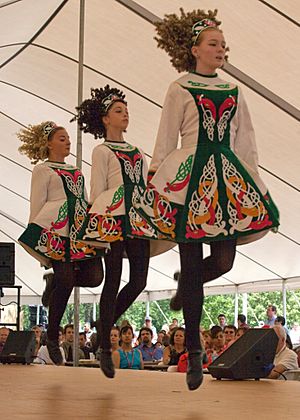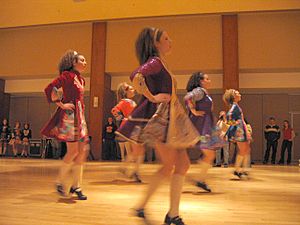Irish dance facts for kids
Quick facts for kids Irish dance |
|
|---|---|

Irish dancers in modern Irish dancing costumes, wearing makeup and ringleted wigs for performance display
|
|
| Medium | Dance |
| Types |
|
| Ancestor arts | |
| Originating culture | Irish |
| Originating era | 18th century |
Irish dance is a fun and energetic type of traditional dance that comes from Ireland. People enjoy Irish dance in many ways: by themselves, in groups, for parties, in competitions, and for shows. This dance style grew from different influences, like French and English dances, during the 1700s and 1800s.
Back then, "travelling dance masters" taught dance all over Ireland. Different dance styles grew in different areas. Irish dance became a very important part of Irish culture. It was especially important for groups who wanted to celebrate Irish identity. In the early 1900s, groups started to organize and set rules for the different dance forms. They created competitions and standard ways of dancing.
Solo Irish dance includes the most famous type, Irish step dance. This style became very popular after 1994 because of shows like Riverdance. Many people around the world who have Irish family (the Irish diaspora) practice it. Step dance is known for dancers keeping their upper body stiff and doing fancy footwork. Other solo styles include sean-nós dance, which is a relaxed and social dance with made-up steps. There's also festival Irish dance, which became a separate style in the mid-1900s.
Irish dancing in groups has many styles. These styles came from French and English dances. Ceili dance is done by groups of two to sixteen people. It uses traditional or set dances and formations. The footwork is simple, and the focus is on the group's movements. Set dance is mostly a social dance for groups of four dancers. It includes some of the fancy footwork found in step dance.
Contents
What is Irish Stepdance?
Many kinds of solo Irish dance are called stepdance. The most well-known is "modern" stepdance, which is done in competitions. There's also old-style stepdance, which is more like how people danced in the 1800s. Festival dance is another type that separated from modern stepdance in the mid-1900s.
Modern Stepdance Style

The most common type of Irish stepdance is the one made famous by the Riverdance show. This style became popular in the late 1900s. Dancers keep their upper body stiff and dance high on the balls of their feet.
Special Shoes for Dancing
Some softshoe dance steps are similar to Scottish country dancing. However, these two styles are different. Tap dance was also influenced by Irish Step Dancing. Unlike softshoe dancing, hardshoe dancing involves hitting the floor rhythmically and very fast with the tips of the shoes.
In competitive step dancing, dancers wear three types of shoes: hardshoes and two kinds of softshoes. The hardshoe (also called "heavy shoe" or "jig shoe") looks a bit like a tap shoe. But its taps are made of wood, fiberglass, or resin, not metal. Early hard shoes did have metal taps. In the 1600s and 1700s, people would hammer nails into their shoe soles. This made the shoes last longer. Dancers used the sounds from these nails to create rhythms. Later, the soles were changed to resin or fiberglass to make them lighter.
Each hardshoe has eight parts that can make sounds. These include the toe, bottom, and sides of the front tap. They also include the back, bottom, and sides of the heel tap. Hardshoes are made of black leather with flexible soles. Sometimes, the front taps are filed down. This lets the dancer stand on their toes, like in pointe shoes. Hardshoes are worn for dances like the hornpipe, the treble jig, and the treble reel. All dancers, no matter their gender or age, wear the same hardshoes.
Images for kids
See also
 In Spanish: Danza irlandesa para niños
In Spanish: Danza irlandesa para niños






